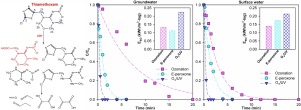当前位置:
X-MOL 学术
›
J. Hazard. Mater.
›
论文详情
Our official English website, www.x-mol.net, welcomes your
feedback! (Note: you will need to create a separate account there.)
Kinetics and mechanism of thiamethoxam abatement by ozonation and ozone-based advanced oxidation processes.
Journal of Hazardous Materials ( IF 12.2 ) Pub Date : 2020-01-23 , DOI: 10.1016/j.jhazmat.2020.122180 Huijiao Wang 1 , Juhong Zhan 1 , Lingwei Gao 1 , Gang Yu 1 , Sridhar Komarneni 2 , Yujue Wang 1
Journal of Hazardous Materials ( IF 12.2 ) Pub Date : 2020-01-23 , DOI: 10.1016/j.jhazmat.2020.122180 Huijiao Wang 1 , Juhong Zhan 1 , Lingwei Gao 1 , Gang Yu 1 , Sridhar Komarneni 2 , Yujue Wang 1
Affiliation

|
In this study, the abatement of neonicotinoid insecticide, thiamethoxam, by single ozonation, ozone/ultraviolet (O3/UV) and electro-peroxone (EP) process was evaluated. The second-order rate constants for the reaction of thiamethoxam with O3 and hydroxyl radical (OH) at pH 7 were determined to be 15.4 M-1 s-1 and 3.9 × 109 M-1 s-1, respectively. The degradation pathways of thiamethoxam were proposed based on quantum chemical calculations and transformation products were identified using chromatographic and mass-spectrometric techniques. The acute and chronic toxicity of thiamethoxam and its major TPs to various aquatic organisms were assessed. With typical ozone doses applied in water treatment (≤5 mg/L), thiamethoxam was abated by only ∼16-32 % in two real water matrices (groundwater and surface water) during single ozonation, but by ∼100 % and >70 % during the O3/UV and EP treatment, respectively. The energy demand to abate 90 % thiamethoxam in the two water matrices was generally comparable for single ozonation and the EP process (∼0.14 ± 0.03 kW h/m3), but higher for the O3/UV process (0.21-0.22 kW h/m3). These results suggest that single ozonation is unable to sufficiently abate thiamethoxam under typical conditions of water treatment. Therefore, ozone-based advanced oxidation processes are needed to enhance thiamethoxam abatement.
中文翻译:

臭氧化和基于臭氧的高级氧化工艺消除噻虫嗪的动力学和机理。
在这项研究中,评估了通过单次臭氧化,臭氧/紫外线(O3 / UV)和电子过氧化物(EP)工艺消除新烟碱类杀虫剂噻虫嗪的效果。噻虫嗪与O3和pH值为7的羟基自由基(OH)反应的二级速率常数分别确定为15.4 M-1 s-1和3.9×109 M-1 s-1。根据量子化学计算提出了噻虫嗪的降解途径,并通过色谱和质谱技术鉴定了转化产物。评估了噻虫嗪及其主要TP对各种水生生物的急性和慢性毒性。在水处理中使用典型的臭氧剂量(≤5mg / L)时,在一次臭氧化过程中,在两种真实的水基质(地下水和地表水)中,噻虫嗪仅减少了约16-32%,但在O3 / UV和EP处理期间分别降低了约100%和> 70%。通常,在两种水基质中减少90%的噻虫嗪的能量需求在单次臭氧化和EP工艺中可比(约0.14±0.03 kW h / m3),而在O3 / UV工艺中则更高(0.21-0.22 kW h / m3)。 )。这些结果表明,单次臭氧氧化不能在典型的水处理条件下充分消除噻虫嗪。因此,需要基于臭氧的高级氧化工艺来增强噻虫嗪的减排效果。这些结果表明,单次臭氧氧化不能在典型的水处理条件下充分消除噻虫嗪。因此,需要基于臭氧的高级氧化工艺来增强噻虫嗪的减排效果。这些结果表明,单次臭氧氧化不能在典型的水处理条件下充分消除噻虫嗪。因此,需要基于臭氧的高级氧化工艺来增强噻虫嗪的减排效果。
更新日期:2020-01-23
中文翻译:

臭氧化和基于臭氧的高级氧化工艺消除噻虫嗪的动力学和机理。
在这项研究中,评估了通过单次臭氧化,臭氧/紫外线(O3 / UV)和电子过氧化物(EP)工艺消除新烟碱类杀虫剂噻虫嗪的效果。噻虫嗪与O3和pH值为7的羟基自由基(OH)反应的二级速率常数分别确定为15.4 M-1 s-1和3.9×109 M-1 s-1。根据量子化学计算提出了噻虫嗪的降解途径,并通过色谱和质谱技术鉴定了转化产物。评估了噻虫嗪及其主要TP对各种水生生物的急性和慢性毒性。在水处理中使用典型的臭氧剂量(≤5mg / L)时,在一次臭氧化过程中,在两种真实的水基质(地下水和地表水)中,噻虫嗪仅减少了约16-32%,但在O3 / UV和EP处理期间分别降低了约100%和> 70%。通常,在两种水基质中减少90%的噻虫嗪的能量需求在单次臭氧化和EP工艺中可比(约0.14±0.03 kW h / m3),而在O3 / UV工艺中则更高(0.21-0.22 kW h / m3)。 )。这些结果表明,单次臭氧氧化不能在典型的水处理条件下充分消除噻虫嗪。因此,需要基于臭氧的高级氧化工艺来增强噻虫嗪的减排效果。这些结果表明,单次臭氧氧化不能在典型的水处理条件下充分消除噻虫嗪。因此,需要基于臭氧的高级氧化工艺来增强噻虫嗪的减排效果。这些结果表明,单次臭氧氧化不能在典型的水处理条件下充分消除噻虫嗪。因此,需要基于臭氧的高级氧化工艺来增强噻虫嗪的减排效果。









































 京公网安备 11010802027423号
京公网安备 11010802027423号